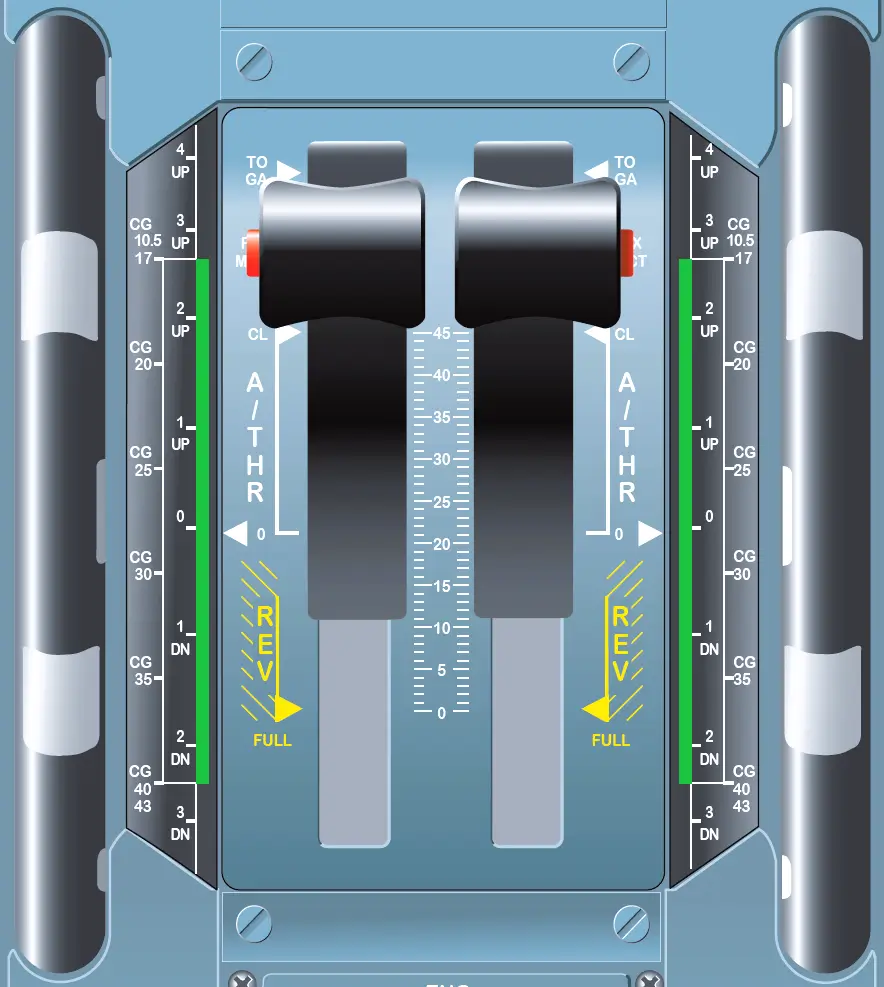A320 THRUST LEVER & PITCH TRIM
The Airbus A320 has FADEC dedicated to each engine to control thrust. The pilot uses the thrust levers to set the thrust in manual mode, and the FMGS sets the thrust in automatic mode (A/THR (Autothrust) function). The thrust levers are only manually moved.


THRUST LEVERS
The flight crew uses the thrust levers in order to:
- Adjust the thrust, or
- Select a thrust stop or detent, or
- Control the deployment and the stowage of the associated reversers, or
- Adjust the associated reverse thrust.
The flight crew can move each thrust lever individually. The position of the thrust levers appears on the E/WD, via a blue circle on the thrust gauge. The flight crew can move each thrust lever forward the Idle (0) stop, when the associated thrust reverser lever is set to the locked position. The flight crew can move each thrust lever backward the Idle (0) stop, when the associated thrust reverser lever is in the unlocked position.
THRUST DETENTS AND STOPS
There are three stops and three detents:
- Rev Max (F or FULL) stop
- Rev Idle (R or REV) detent
- Idle (0) stop
- Climb (CL) detent
- Maximum Continuous Thrust (MCT)/Flexible Take Off (FLX) detent
- Takeoff (TO)/Go-Around (GA) stop.
THRUST REVERSER LEVERS
The flight crew uses the thrust reverser levers in order to unlock the associated thrust lever. The flight crew can move each thrust reverser lever upward to the unlocked position, when the associated thrust lever is set to the Idle (0) stop. The thrust reverser levers are automatically reset to the locked position, when the flight crew moves the thrust levers forward the Idle (0) stop.
A/THR Instinctive Disconnect pb
Pressing the A/THR instinctive disconnect pb disconnects the A/THR.
PITCH TRIM Wheel
- Both pitch trim wheels provide mechanical control of the THS and have priority over electrical control. A pilot action on the pitch trim wheel disconnects the autopilot.
- Note: Crew action on the pitch trim wheel does not disconnect the ELACs (micro-switches, actuated by the override mechanism, ensure that the computers remain synchronized with the manually-selected position).
The THS is manually-controlled on ground for the THS setting, before takeoff and in flight, when in direct law.
- Before takeoff, the pilot sets the THS to the angular value, determined as a function of the aircraft CG, using the CG scale on the wheel. The relationship between the aircraft CG and the THS setting shown on the trim wheel is only applicable for takeoff. The limits of the THS normal setting range for takeoff are indicated by a green band on the pitch trim wheel.
- In flight, when in direct law, the pilot uses the THS conventionally to fly in trim. In flight, the aircraft pitch trim setting depends on aircraft CG, weight, altitude and speed. Consequently, the relation between the aircraft CG, and the THS setting displayed on the pitch trim wheel, does not apply in flight.
Following nosewheel touchdown, as the pitch attitude becomes less than 2.5 ° for more than 5 s, pitch trim is automatically reset to zero.
Note: This function is inoperative, when the green or yellow hydraulic system is not pressurized.
